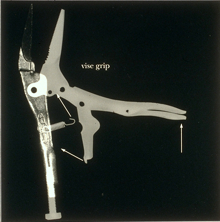I confess that I actively enjoy Project Runway. The show has its cheesy elements, to be sure, because it has to follow the reality show model of having back-stage drama, strange revelations, and somewhat difficult personalities.
But, in the end, it's about art and critique. The designers they recruited are talented people. Much more so here in Season 3; we've been watching Season 1 on DVD, and it's much more wacky and with people who have less skill on average, although some have quite good art and craft abilities.
 Fashion design isn't graphic design, but they share a remarkable number of properties in common. It's a combination of art, craft, commerce, and communication. You need unique artistic vision to create someone. You need craft to take the idea in your head and put it on paper, on a manikin, cut it out, sew it, fix it. That's a sculptor's combination of two-dimensional and three-dimensional visualization and enactment, coupled with a filmmaker's insight into how a 3D object moves through space.
Fashion design isn't graphic design, but they share a remarkable number of properties in common. It's a combination of art, craft, commerce, and communication. You need unique artistic vision to create someone. You need craft to take the idea in your head and put it on paper, on a manikin, cut it out, sew it, fix it. That's a sculptor's combination of two-dimensional and three-dimensional visualization and enactment, coupled with a filmmaker's insight into how a 3D object moves through space.
The communications comes from taking elements that in themselves have little or no semantic meaning, no symbolism of any real kind, and through assemblage, produce a message that someone can read visually. And that each person may read slightly differently, too.
Finally, the commerce. You have to sell the thing you make. Or sell yourself as the person who has the idea of the thing you made.
Graphic design's key difference is that we have a streamlined relationship from conception through realization typically in two dimensions. Graphic designers now work through a lot of 3D and 4D media, of course, and even a poster has to be conceived as viewed on 2D plane from many angles. Monumental design, even flat, has 3D and 4D properties.
In a terrific class I had at the Yale Summer Program in Graphic Design in Brissago, Switzerland, we studied for a week with Richard Sapper, the designer of the Tizio lamp and a thousand other interesting projects. We had to create a sculpture from a single sheet of white heavy paper stock that, as it rotated through 360 degrees, had a constantly changing and surprising view. A good exercise for a graphic designer.
 Project Runway poses challenges that are not unfamiliar to those of us who studied art, architecture, or other forms of design. Short periods of time to accomplish some unique, interesting, and well made. We didn't get fabulous prizes (just grades), and the periods of times and oddity of the tasks were kept within normal parameters.
Project Runway poses challenges that are not unfamiliar to those of us who studied art, architecture, or other forms of design. Short periods of time to accomplish some unique, interesting, and well made. We didn't get fabulous prizes (just grades), and the periods of times and oddity of the tasks were kept within normal parameters.
But whenever Tim wanders through the room, I'm reminded of John Gambell, now the Yale University Printer, who critiqued and led in that gentle way--Tim's a bit sterner at times. No vagueness. Lots of specific direction. An assumption that the artist can actually create something worthwhile. I get a lot of frission from watching the show because so many elements remind me so much of that idyllic period of life when I could just make and see what came of it.
